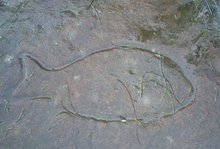



Herbicides kill unwanted plants
Biocides "have been designed to disrupt biological systems, causing death to target organisms, such as insects or plants"
They have been used in warfare to make the leaves fall off the trees in the rainforest(Agent Orange). The damage was great on all life and some victims fought a class action lawsuit about the poisoning.
These chemicals are not just used in warfare for eradicating life, they can also be put to use as chemical weapons to remove unwanted plants for example.
Once a place industrialises, that is it relies on fossil fuel machinery and chemicals for 'vegetation control' then the costly “rapid knockdown ability” of these toxins saves the labourer from bending down and picking up a weed.
Lately there have been many signs of the use of such substances in public areas that are highly frequented by people, pets and wildlife.
At the end of Bower St at the Shelly Headland Loookout where some Bitou weed (Chrysanthemoides monilifera*ssp) needed to be 'managed' a whole swath of native plants are dead or dying: Mangrove Boobialla (Myoporum ssp.), NZ spinach (Tetragonia tetragonioides) and Saltbush (Enchylaena). All of the endemic flora provided habitat for native marsupials and birds. It appears to be a very inefficient 'by-kill'. The location is on the cliff's edge so runoff is an issue. Why the remaining woody shrubs and trees are butchered is another question.
Around immersive Manly Town many poles have that iconic Australian 'one grass' sprouting at the bottom. The same signs of herbicide death. Even at the beach, the vegetation at the sandstone wall also shows the same signs. A sign of surface runoff?
Who knows what the turf along the pines contains which children and dogs are rolling in. Both toddlers and dogs are low to the ground and stand to be in closer contact.
Council's website was last updated in 2007 on the matter and reads:
"The aim of this plan is to meet the community’s general right to know about pesticide applications made to outdoor public places that are owned or controlled by Manly Council. The plan allows members of the community to take action to avoid contact with pesticides if they wish. Manly Council aims to ensure that pesticides are applied to public places in a safe, responsible and humane manner, minimising harm to the community and the environment."
In a more current document council mentions that "70 litres or less of herbicide is to be used annually".
- How is the public informed?
- How is information made available?
- How can residents/visitors/pets reduce exposure to land or beach where hazardous chemicals have been applied or have run to?
- Why aren' t there any signs?
A community of users might have certainty at the moment, but history has taught that the Precautionary Principle is always a good guide. The impacts on peoples' health, the well-being of pets or the environmental impacts will, as usual come years later.
Images:
1 & 2, Poles with dead grass in Manly town, close to Manly Beach
3 Dead vegetation at the beach stairs. Run off?
4 Various Mangrove Boobialla at Shelly Headland Loookout dying.
Links
Endocrine Disruptors
Some Reasons to not use Herbicides
Glyphosate
Update:
040509
North Head , Lady Fairfax walk and lookouts also seem to be befallen by the great 'browning'. Weeds especially along the fences are doing well. Endemic plants are hit. Eutrophication down the cliff from the lookout.
260609
" Weed killer kills human cell... Used in yards, farms and parks throughout the world, Roundup has long been a top-selling weed killer. But now researchers have found that one of Roundup’s inert ingredients can kill human cells, particularly embryonic, placental and umbilical cord cells." Environmental Health News, 220609
Nora Benachour and Gilles-Eric Sralini, Glyphosate Formulations Induce Apoptosis and Necrosis in Human Umbilical, Embryonic, and Placental Cells, Chem. Res. Toxicol., 2009, 22 (1), pp 97–105 DOI: 10.1021/tx800218n Publication Date (Web): December 23, 2008











No comments:
Post a Comment